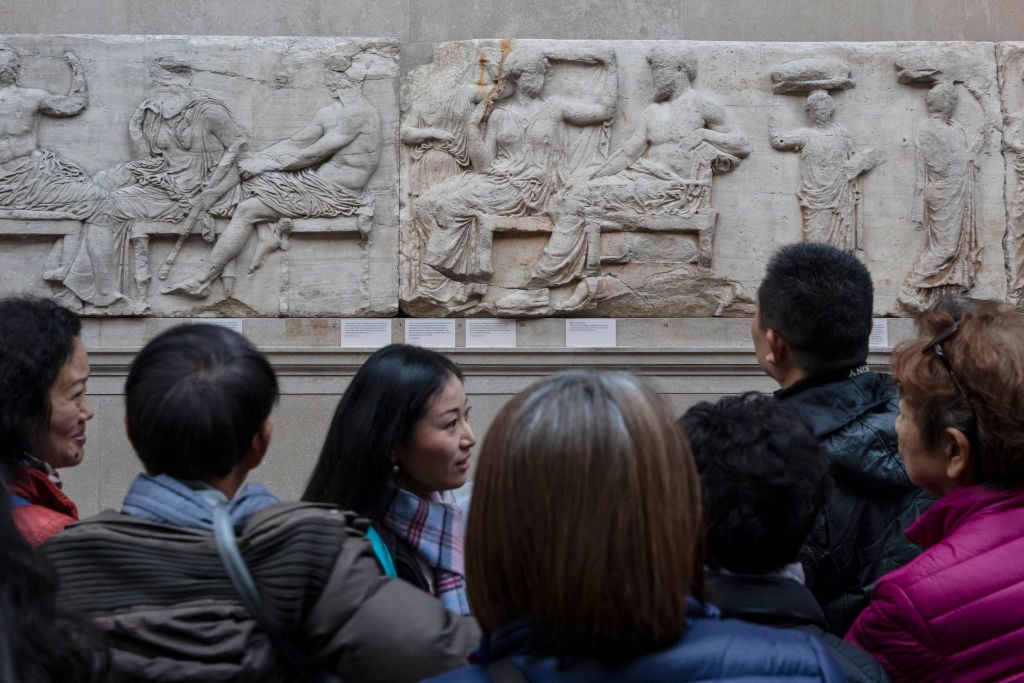
The Institute of Digital Archaeology (IDA) has filed a freedom of information request to the British Museum after the London museum refused to grant the institute permission to make a 3-D scan of the contested Parthenon Sculptures, which are in its holdings.
The IDA’s lawyer submitted the request to the British Museum on Friday, April 1, and sent a second document requesting additional information Monday this week. This amounts to the IDA’s first legal step towards seeking to compel the museum, eventually through a London court, to allow it to make a 3-D scan of the marble works, which originate in 5th century B.C. Athens, Greece—they were removed by the Earl of Elgin in the 19th century.
The request, which the British Museum would neither confirm nor deny receiving, is based on the U.K.’s Freedom of Information Act (FOIA), passed in 2000, that provides public access to information held by public authorities.
“We’re asking the British Museum for a five-year history of what [public inspection] requests it has received, how many requests have been granted and to whom those requests have been granted,” Roger Michel, the American founder and executive director of Oxford-based IDA, told Artnet News. “What we’ll learn from this FOIA request is whether around 25 to 50 percent of those requests have been granted or whether the number is only 1 or 0.5 percent.”
Sections of the Parthenon Marbles at The British Museum. Photo by Dan Kitwood/Getty Images.
Founded in 2012, the IDA is a joint venture between Harvard University, Oxford University, and Dubai’s Museum of the Future, focused on digital imaging techniques in archaeology. It digitally reconstructed Palmyra’s third century “Triumphal Arch”, which was destroyed by the Islamic State group in 2015.
The IDA is a vocal advocate for the return of the Parthenon Sculptures to Greece, and Michel has met with the Greek ambassador to Britain, Ioannis Raptakis, to show support for Greece’s restitution demands. The ultimate aim, Michel said, is to “create a reconstruction of the sculptures” that could replace those inside the British Museum in order for the originals to be sent back to Athens.
The Parthenon Sculptures, also referred to as the Elgin Marbles, were removed from the Acropolis in the early 19th-century by Thomas Bruce, Earl of Elgin, when he was serving as Britain’s ambassador to the Ottoman Empire, which then occupied Greece. Greece has persistently demanded they be returned.
“In their current condition, the sculptures bear no relation to those created by Phidias in his studio [in the fifth century B.C.],” Michel said. “They’re missing significant amounts of material—the heads, toes, arms and legs are all gone. And the surface detail has been seriously eroded by the environmental conditions in Athens over the centuries and been subjected to highly corrosive cleaning by the British Museum.”
After its earlier request to make a 3-D scan outside of visiting hours was declined, the IDA entered the British Museum during visiting hours to make a partial scan using a hand-held camera last month.
Part of the Parthenon Marbles at the British Museum. Photo: by VCG Wilson/Corbis via Getty Images.
In recent years, opinion has tipped in favor of Greece, as awareness around colonialism and restitution has grown. In October 2021, the UNESCO’s intergovernmental commission for the return of cultural property voted unanimously to issue a recommendation for the return of the Parthenon Sculptures, a request that Greece first raised to UNESCO back in 1984. UNESCO, which cited the “poor conditions” of display at the British Museum, concluded that the matter was “intergovernmental” rather than institutional, meaning that the decision is beyond the British Museum’s jurisdiction.
The U.K., which advocates that the sculptures were removed legally in agreement with the Ottoman Empire, rejected UNESCO’s recommendation.
In a statement released to Artnet News, the British Museum said it received regular requests to scan objects in its collection. “We facilitated the scanning of the Parthenon Sculptures by our colleagues from the Acropolis Museum in Athens on two occasions in 2013 and 2017,” the statement read. “We work hard to accommodate scanning and study requests where possible. It’s important to us that any request is properly supported so that we can ensure the highest levels of quality and accuracy and this is always balanced against our other commitments and work as an institution.”
If the British Museum complies with the FOIA request, the IDA will then ask a London equity court for a “declaratory relief”, which is essentially a statement pertaining to its request to make a 3-D scan of the Parthenon Sculptures. If the British Museum does not comply with the FOIA request, the IDA will use “a judicial mechanism” to compel it to do so, Michel added.
The IDA’s request also refers to the British Museum Act of 1963, which mentions that the duty of trustees is to make objects comprised in collections available for inspection to the public, providing this is “practicable” and under conditions fit for “preserving the safety of the collections and ensuring the [museum’s] proper administration.”
The British Museum is not the only European museum facing 3-D scanning requests from American entrepreneurs. Cosmo Wenman, an American fabrication consultant and open-access activist, has filed a lawsuit against the Musée Rodin in Paris to force it to release its 3-D scans of Auguste Rodin’s sculptures, also on the grounds of freedom of information.
“I’ve already forced the Musée Rodin to publish two of its 3D scans, Le Baiser and Le Sommeil,” Wenman told Artnet News. On Twitter, Wenman specified that he received a download link to a terracotta version of Le Baiser and a plaster version of Le Sommeil. Wenman has aimed to gain access to the 3D scans in order to make commercial, unlimited bronze reproductions in various sizes. The longstanding lawsuit is ongoing.